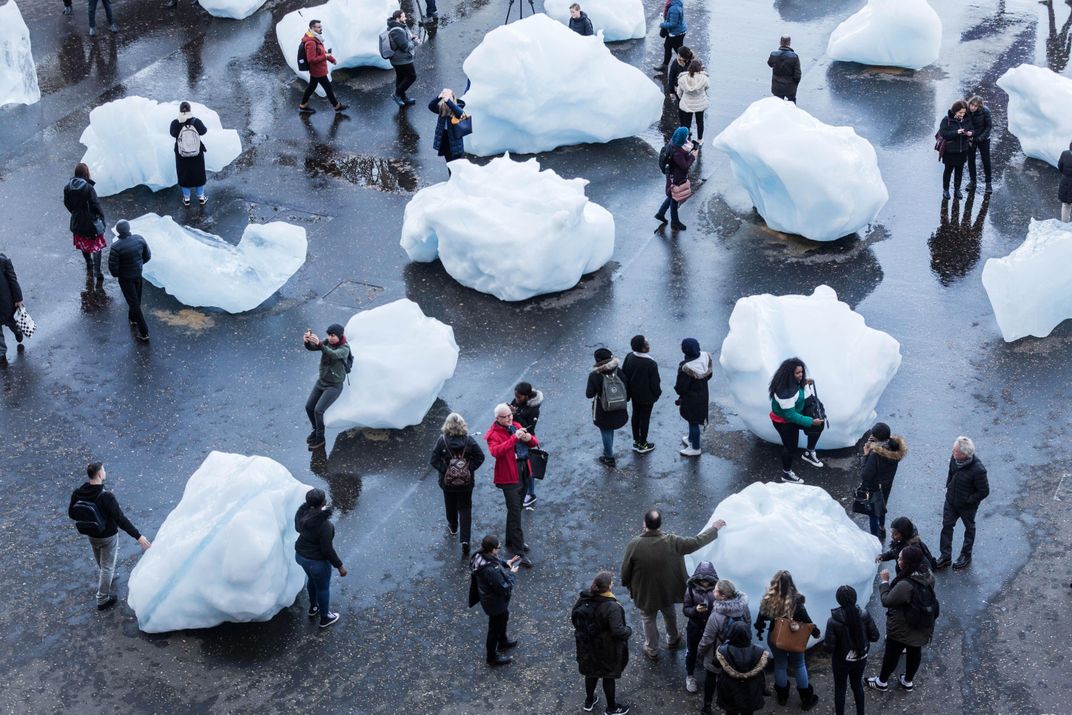Straight From a Greenland Fjord, London Installation Sends Dire Message on Climate Change
Olafur Eliasson’s ‘Ice Watch’ aims to bring viewers into direct confrontation with the devastation wrought by global warming
/https://tf-cmsv2-smithsonianmag-media.s3.amazonaws.com/filer/16/50/165027ff-4ff9-4fc4-b17f-f05deae062d3/jalsut_181211_icewatch_opening_4164.jpg)
If you’re hoping to catch Olafur Eliasson’s latest public art installation, you’d better hurry. As its title suggests, “Ice Watch” is a startlingly literal project that finds the Icelandic-Danish artist and geologist Minik Rosing adorning the streets of London with 30 chunks of rapidly melting ice imported straight from a Greenland fjord.
The immersive work—visitors are free to touch, climb on and even, yes, lick the blocks—is designed to bring viewers into direct confrontation with the devastation wrought by climate change: As Eliasson tells the Guardian’s Tim Jonze, “In order to create the massive behavioral change needed [to fight global warming], we have to emotionalize that data, make it physically tangible.”
According to Naomi Rea of artnet News, the installation, which consists of 24 icebergs laid out in a clock-like formation in front of Tate Modern and six placed outside of Bloomberg’s London headquarters, is timed to coincide with the COP24 climate change conference currently being held in Poland. “Ice Watch” also echoes the Intergovernmental Panel on Climate Change’s recent warning that humans only have 12 years left to combat the most dire effects of climate change.
Writing for the Art Newspaper, Ben Luke explains that Eliasson and Rosing harvested the blocks from the waters of the Nuup Kangerlua fjord, where they’d landed after breaking off from the Greenland ice sheet. The pair shipped the hefty icebergs—Jonze notes the blocks weighed between 1.5 and 6 tons each—to Immingham, England, in nine refrigerated containers, then transported them to London via truck. Once the blocks were lowered into place via crane, the installation was officially ready for its debut on Monday, December 11.
Each slab can be seen as embodying its own distinct personality. “Some are near translucent, others densely opaque; some have lightly cratered surfaces, others are ice-rink slick,” Elly Parsons observes for Wallpaper*. Speaking with the Guardian’s Jonze, Eliasson adds that the compressed snow blocks (as opposed to chunks of frozen water) produce popping and fizzing sounds as they melt into the London sidewalk. Since the trapped air responsible for this phenomenon likely originated tens of thousands of years ago, it contains almost half the carbon dioxide content as the air outside of the iceberg.

Greenland’s ice sheet loses 10,000 blocks comparable to the sizes of the 30 currently on view in London every second, Rosing tells the Art Newspaper’s Luke. Meanwhile, global sea levels rise by approximately 0.3 millimeters per year, and temperatures topping the highest ever recorded are measured on a regular basis. But the goal of “Ice Watch” isn’t fear mongering. Instead, the installation simply aims to bring the realities of climate change closer to home.
“I think everybody at this point thinks about climate change but it remains relatively abstract,” Eliasson tells the Telegraph’s Anita Singh. “Here the ice is actually real, it’s not something far away in Greenland.
It’s worth noting that the act of transporting 30 icebergs from Greenland to England engenders a significant carbon footprint in and of itself. As a spokesperson for the artist’s studio tells artnet News’ Rea, the average amount of energy expended bringing each block to London is roughly equivalent to one individual flying from London to the Arctic. To offset this carbon cost, Eliasson and his collaborators plan on donating three times the amount of money it would take to cover 30 such flights to the United Kingdom’s Woodland Trust charity.
The London installation is the third iteration of “Ice Watch,” according to the Art Newspaper. Eliasson first staged the work in Copenhagen in 2014, then in Paris in 2015. Each installation has been timed to coincide with a significant development in the fight against climate change: In Copenhagen, “Ice Watch” marked the publication of the United Nation’s Fifth Assessment Report on Climate Change, and in 2015, the installation accompanied the COP21 talks that resulted in the Paris Agreement.
But the latest version of “Ice Watch” is by far the most ambitious, encompassing more than double the number of icebergs included in the Copenhagen and Paris installations. The scale of the project doesn’t make it any less ephemeral. As a real-time ice tracker published on the Ice Watch London website shows, just one day into their display, the blocks have already shrunk in size.
Eliasson estimates they could completely disappear as soon as the weekend, melting into the River Thames just as the vanishing ice sheets of Greenland promise to one day flood bodies of water across the globe.
/https://tf-cmsv2-smithsonianmag-media.s3.amazonaws.com/accounts/headshot/mellon.png)
/https://tf-cmsv2-smithsonianmag-media.s3.amazonaws.com/accounts/headshot/mellon.png)